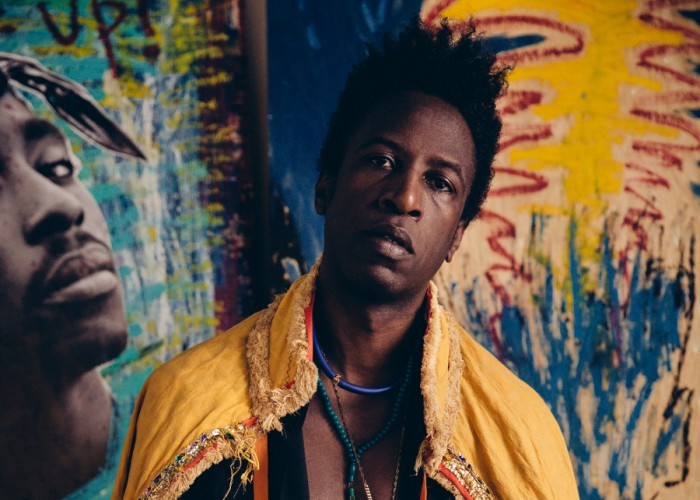Oct 28, 2025 10:47 AM
In Memoriam: Jack DeJohnette, 1942–2025
Jack DeJohnette, a bold and resourceful drummer and NEA Jazz Master who forged a unique vocabulary on the kit over his…

Spoken word artist Saul Williams contributed to David Murray’s Blues For Memo (Motéma).
(Photo: Geordie Wood)You mentioned in the past that you initially had trepidations about jazz.
I dodged jazz publicly, because I didn’t want to be pigeonholed. There’s something about poetry that makes it easier for you to get associated with either some snappin’-your-fingers r&b, Common/Jill Scott shit or some jazz shit.
So, I stood alongside a lot of the electronic shit and rock shit just to juxtapose the idea of what spoken word was associated with at the time. Plus, I always felt that what I was doing was punk in a public sense. But despite that I found myself collaborating with a cellist or a saxophonist, albeit on a different level.
Now that I’m working with David Murray, I feel like this is just the tip of the iceberg. It’s been coming, and I basically stopped refusing it. I’m on the road with these guys now, but before this I did some shows with Preservation Hall. And then my new neighbor is Christian Scott, who has been coming over, and we’ve been exchanging music and ideas. I had been vibing with him—be it on the phone or online—for like 10 years now. But we never got to sit down and make music together until about a month ago. There’s so much going on with me in this world right now, I imagine this is just the beginning.
Has the way you listen to jazz changed?
I spend a lot of time going back and discovering the forefathers of this creative jazz shit, just because I felt like I needed to have a working knowledge of what all these older cats are trying to instill in me and what they were referencing. It’s really interesting to hear all of these distinctions.
I was talking to Christian Scott [recently], and he was telling me when he was a kid, he wasn’t allowed to listen to anyone who was alive. That was the rule in his house, because you don’t want to have a style that’s compared to anybody contemporary.
Lyricist Lounge, Vol. 1 was released 20 years ago. Was the journey from poetry to hip-hop similar to your journey into jazz?
The Lyricist Lounge thing was literally just a natural progression from what I was doing at the Nuyorican Café, and then getting in with Stretch and Bobbito, who had made a night of hip-hop and poetry there. And I was always on the poetry side. But because of that, a lot of MCs recognized what I was doing and saw there was a relationship to rapping. So, they were OK with complimenting me, because I wasn’t an MC and I wasn’t trying to battle them. As a result, they started being really generous and inviting me out to participate in these jam sessions called “ciphers.”
It also had a lot to do with the fact that commercial hip-hop was pushing away from lyricism during that time period with the gangsta explosion and Puff Daddy and all that. So, cats in New York were really into the boom bap and exploring it even further. And when I think of it now, there was definitely a spirit of jazz in that period of hip-hop, with those freestyle ciphers. It was similar, to me, to what was going on in the ’60s and ’70s during the whole loft-jazz era. And I think, even if it was subconsciously, we felt that and we dug it. There was definitely a feeling of jazz at the Lyricist Lounge. DB

Jack DeJohnette boasted a musical resume that was as long as it was fearsome.
Oct 28, 2025 10:47 AM
Jack DeJohnette, a bold and resourceful drummer and NEA Jazz Master who forged a unique vocabulary on the kit over his…

D’Angelo achieved commercial and critical success experimenting with a fusion of jazz, funk, soul, R&B and hip-hop.
Oct 14, 2025 1:47 PM
D’Angelo, a Grammy-winning R&B and neo-soul singer, guitarist and pianist who exerted a profound influence on 21st…

To see the complete list of nominations for the 2026 Grammy Awards, go to grammy.com.
Nov 11, 2025 12:35 PM
The nominations for the 2026 Grammy Awards are in, with plenty to smile about for the worlds of jazz, blues and beyond.…

Drummond was cherished by generations of mainstream jazz listeners and bandleaders for his authoritative tonal presence, a defining quality of his style most apparent when he played his instrument unamplified.
Nov 4, 2025 11:39 AM
Ray Drummond, a first-call bassist who appeared on hundreds of albums as a sideman for some of the top names in jazz…

Flea has returned to his first instrument — the trumpet — and assembled a dream band of jazz musicians to record a new album.
Dec 2, 2025 2:01 AM
After a nearly five-decade career as one of his generation’s defining rock bassists, Flea has returned to his first…





